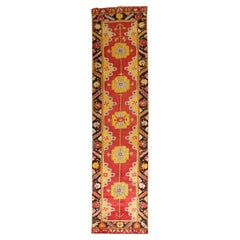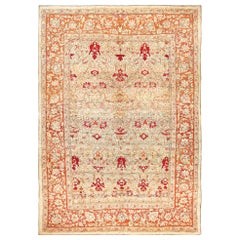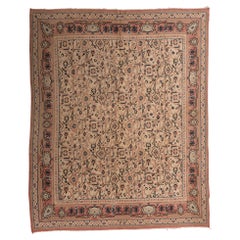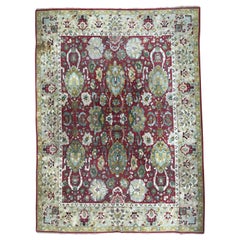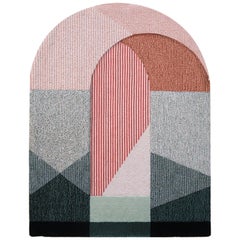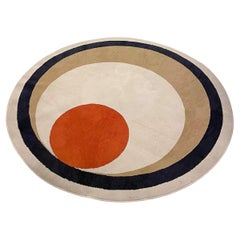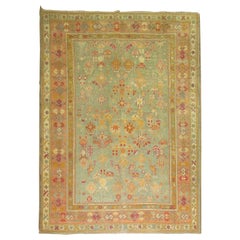Agra Western European Rugs
12
to
1
6
6
12
12
12
2,476
430
405
150
127
40
36
34
27
23
12
12
10
9
8
5
4
2
3
9
3
5
Width
to
Length
to
12
12
1
7
4
4
2
2
Style: Agra
nice mid century French Janus, Lys points rug
Located in Saint Ouen, FR
Nice mid century French Janus rug with beautiful oriental antique rugs design and nice colours with a red field, green, yellow, sky blue, brown and white, hand made with the Janus Ly...
Category
Mid-20th Century French Agra Western European Rugs
Materials
Wool
Zabihi Collection Early 20th Century Karapinar Bright Turkish 13 Foot Runner
Located in New York, NY
An early 20th century rich vibrant color turkish karapinar runner.
Measures: 3'2'' x 13'.
Category
Early 20th Century Agra Western European Rugs
Materials
Wool
Antique Indian Agra Rug. 10 ft 3 in x 14 ft 4 in
Located in New York, NY
Beautiful floral antique room size Indian Agra rug, country of origin: India, date circa 1880. Size: 10 ft 3 in x 14 ft 4 in (3.12 m x 4.37 m)
This magnificently beautiful rug would at first appear to be Persian or perhaps even a French rug, but if one examines it in person, they will see that it is undoubtedly a great antique Indian Agra carpet. In the 1880’s, the popularity of Oriental and Persian rugs found their way into formal Victorian interior design. During this time, many cities began producing carpets that were not previously known as centers for weaving and the arts. Antique Indian Agra carpets rose...
Category
Late 19th Century Indian Antique Agra Western European Rugs
Materials
Wool
Large Kilim Bessarabia with Pale Colors
Located in Alessandria, Piemonte
nr. 575 - Discreet pale rose color for this elegant Bessarabia vintage kilim with nice measures, suited for a sitting or a sleeping room.
Interesting also without the usual central ...
Category
Early 20th Century Romanian Agra Western European Rugs
Materials
Wool
Bobyrug’s Beautiful Large French Janus Rug Agra Design
Located in Saint Ouen, FR
Nice midcentury French Janus rug made in point de Lys manufacturing, very decorative with beautiful Agra design and nice colors with purple, green, blue and yellow. Entirely handmade...
Category
Mid-20th Century French Agra Western European Rugs
Materials
Wool, Cotton
Bobyrug’s Beautiful Antique French Janus Rug
Located in Saint Ouen, FR
Nice French Janus or point de Lys rug, with beautiful Agra design and red, blue, green, yellow and pink colors, entirely hand manufactured with Janus method, wool velvet on cotton fo...
Category
Mid-20th Century French Agra Western European Rugs
Materials
Wool
Vintage German Continental Rug. Size: 8 ft 2 in x 11 ft 8 in
Located in New York, NY
Gorgeous Purple Vintage German Continental Rug, Country of Origin: European Rugs, Circa date: Mid 20th Century. Size: 8 ft 2 in x 11 ft 8 in (2.49 m x 3.56 m)
Category
Mid-20th Century German Agra Western European Rugs
Materials
Wool
Beautiful Large Antique French Janus Rug
Located in Saint Ouen, FR
Pretty large distressed French Janus rug with nice decorative Persian stylized design and beautiful colors, entirely hand crafted with « point de Lys » method by wool on cotton found...
Category
Mid-20th Century French Agra Western European Rugs
Materials
Wool
Nice Vintage European Spanish Rug
Located in Saint Ouen, FR
Beautiful Spanish hand knotted rug with a decorative design and a yellow field color with blue, green and pink, entirely hand knotted with wool velvet on cotton foundation.
Category
Early 20th Century Spanish Agra Western European Rugs
Materials
Wool
Large Antique Indian Agra Rug. Size: 10' 8" x 18' 3"
Located in New York, NY
A Remarkable Rare and Breathtaking Large Antique Indian Agra Rug, Country of Origin / Rug Type: Indian Rugs, Circa Date: Late 19th Century. Size: 10 ft 8 in x 18 ft 3 in (3.25 m x 5....
Category
Late 19th Century Indian Antique Agra Western European Rugs
Materials
Wool
Blue Turkish Sivas Carpet
Located in New York, NY
Turkish Sivas carpet with an all-over blue motif rug and ivory border.
Category
20th Century Turkish Agra Western European Rugs
Materials
Wool
Zabihi Collection Late 19th Century Antique Turkish Ghiordes Rug
Located in New York, NY
Late 19th Century Turkish ghiordes accent size rug
3'10'' x 6'
Category
Late 19th Century Turkish Antique Agra Western European Rugs
Materials
Wool
Related Items
Sottoportico Extra Large Full Colors Rug 100% Wool by Portego
By Portego
Located in Stienta, IT
100% top quality New Zealand wool tufted rug
Designed by Seraina Lareida
Made in Italy
The Sottoportico design is inspired by the porches destroyed by the Acqua Alta (high water...
Category
21st Century and Contemporary Italian Agra Western European Rugs
Materials
Wool
Mid-Century Modern Round Graphic Rug, 1970s
Located in Brussels, BE
Mid-Century Modern Round Graphic Rug, 1970s
Category
1970s Vintage Agra Western European Rugs
Materials
Fabric
Vintage Indian Rug with Versace Baroque Style
Located in Dallas, TX
77466, vintage Indian rug with Versace Baroque style. Sure to captivate the most discerning aesthete, this hand knotted wool vintage Indian rug is the epitome of Versace vibes and lu...
Category
Late 20th Century Indian Agra Western European Rugs
Materials
Wool
French Mid-Century Modern Red Wool Rug in the style of André Arbus
Located in Milan, IT
Carpets woven with open fields surrounded by a leafy frame are typical of the so-called French 'neoclassical' artists, of which André Arbus is a leading representative. These artists...
Category
1940s French Vintage Agra Western European Rugs
Materials
Wool
20th Century Turkish Hand Knotted Runner 8
Located in Chicago, IL
Beautiful runner in excellent condition.
Category
20th Century Turkish Agra Western European Rugs
Materials
Wool
Early 20th Century Anatolian Turkish Runner
Located in Chicago, IL
A wonderful and bold early 20th century Anatolian Turkish runner with four large diamond medallions, each woven with a geometric pattern with alternating colored stripes and set agai...
Category
1920s Turkish Vintage Agra Western European Rugs
Materials
Wool
Early 20th Century Handmade Turkish Oushak Runner
Located in New York, NY
An antique Turkish Oushak rug in runner format handmade during the early 20th century.
Measures: 2' 8" x 10' 9"
Turkish rugs & carpets:
Until the Great Persian Carpet Revival in the later 19th century, the “Oriental rug” was Turkish. For nearly six centuries, Turkish rugs, both scatter, room size, and even larger, thoroughly dominated the European import market. Whereas the Persian carpet can be divided into urban, village, and tribal types, in Turkey and its predecessor the Ottoman Empire, rugs almost exclusively came from village weavers and from a small number of urban workshops. Ninety percent village, nine percent city, one percent tribal.
Turkish weavers have, with very few exceptions, always worked with the symmetric (Turkish) knot. Wool foundations are standard practice among both town and village weavers. The exceptions, very finely woven 20th century and recent Herekeh silks from near Istanbul, and early 17th century Ottoman Court rugs from Bursa, constitute only a tiny part of the total. Always pricey, they appealed and still appeal to the clients who want lots of knots and perfect execution instead of individual personality.
The urban workshops have been centered around the western Turkish city of Oushak and its attendant port town of Smyrna. Oushak weaves with the trends in fashion. When color saturated medallion carpets were needed, Oushak was ready in the 17th and 18th centuries. When coarse red and blue carpets were required, Oushak and Smyrna in the 19th century wove them by the boatload. When tastes changed again, and the European dealers in Smyrna wanted room size carpets with lighter and unusual colors, and with Persianate designs, production ramped up in nearby Oushak. Those antique, all-wool construction turn-of-the-century carpets are still in high demand with designers. Antique carpets with allover, roughly drawn patterns on grounds of shrimp, rust, straw, cream, pale blue, and pale and pea green, hitherto unavailable colors, are in such demand today that contemporary Oushaks have attempted to mimic them with soft palettes, extra-large scale drawing and coarse weaves.
Oushaks woven for the Turkish market, for palaces, houses and mosques were often oversize with large, repeating medallions, all in shades of (Turkey) red, dark blue, light blue-teal, and ivory, with lemon and green accents. Turkey, along with India, invented standard sizes. By vertically repeating the medallion, one could get one medallion, one with two end halves, two, three, etc. medallions, up to thirty or so feet in length. The process spared making new cartoons for each length and allowed a quicker turnaround time. Oushak, from the time of 15th century “Holbein” rugs onward, has always been a commercial center.
The prayer niche directional rug is primarily a Turkish development. In the towns and villages east of Oushak, in Ghiordes, Kula, Ladik, Kirsehir, Mucur and Konya, among others, arch pattern scatters with bright palettes and weaves varying from relatively fine to moderate were almost the entire production. Antique examples were particularly popular in America around 1900.
Other centers of village weaving were situated on the western coast and adjacent islands with the town of Melas and neighboring villages weaving geometric prayer rugs and scatters with a characteristic khaki green and lots of yellow.
The other large region was in the northwest of Anatolia, near ancient Troy, with the sizable town of Bergama at its center. The satellite towns of Ezine, Karakecilli, Yuntdag, and Canakkale all wove colorful scatters with moderate weaves in all wool with geometric designs and cheerful palettes. Near to Istanbul, these were among the first Turkish rugs to reach Europe in the Renaissance.
The earliest Turkish pieces depicted in Italian Old Master paintings display the so-called “Memling gul”, an allover panel pattern with hooked and stepped elements within the reserves. This pattern continues for centuries in the Konya area and in the Caucasus as well.
Turkey is a land of villages and much of the most interesting Turkish weaving comes from one undiscovered village or another. The Konya-Cappadocia region of central Turkey includes the active towns of Karapinar, Karaman, Obruk, Sizma, and Tashpinar, all weaving Konya-esque scatters and long rugs. Karapinar has been active the longest, since the 17th century. The mosques in and around Konya have preserved locally-made rugs from the fourteenth. In the 20th century, the extra-long pile, many wefted Tulu rug was devised, with limited palettes and color block patterns. These are not really antique Tulus, but they must be a product of long-standing village tradition.
There are thousands upon thousands of rural Turkish villages, almost all with easy access to local tribal wool. Rug students are discovering new names and rug types almost daily. The common denominators are bright colors, geometric designs, wool construction, moderate to coarse weaves and symmetric knots. Synthetic dyes hit the Turkish rug industry quickly and hard after 1870, and they penetrated to even the most off-the-beaten-track villages. This development was almost entirely negative. The village weavers used fugitive or overly bright dyes which ruined the color harmonies built up over centuries. Characteristic types disappeared or were negatively transmuted. The Turkish village rug of the 1870 to 1920 period is nothing to be proud of.
In the eastern provinces, the semi-nomadic Kurdish tribes, collectively called ‘Yuruks’, weave all wool, geometric pieces with medium to medium-coarse weaves, as well as kilims and other flatweaves. The rugs employ cochineal instead of madder for the reds, mustard yellows, greens, and various blues. They are under-collected like the Persian Afshars. Their rugs are in scatter and long rug formats. The far eastern Turkish town of Erzerum has a long tradition of idiosyncratic, semi-workshop rugs and further to the east is Kars with a tradition of rugs in the Caucasian Kazak manner.
One Turkish specialty is the Yastiks or cushion cover, made in pairs for the public living rooms of village houses. These are larger rugs in miniature and good ones are highly collectible. Like other Turkish rustic weavings, ones with synthetic dyes are almost totally undesirable. Only the tribal Baluch make similar cushion covers, known as pushtis or balishts, in the same small, oblong format. Yastiks always have a back, usually in plain weave, so that they can be easily stuffed.
When the Imperial Carpet Factory at Herekeh near Istanbul closed in the early 20th century, the highly proficient Armenian master weavers set up in the Kum Kapi district of Istanbul where they wove all-silk, exquisitely fine and elaborately detailed small pieces, sometimes enriched with metal thread, for the most discriminating European buyers. Today the best, signed Kum Kapi pieces, usually in the “Sultan’s head” prayer niche design, can fetch upwards of $100,000. They are strictly for the wall. An Interwar all-silk room size Kum Kapi carpet is both exceedingly rare and stratospherically priced. The workshops closed in the 1930s, but the weaving of extremely fine, all-silk small rugs in Herekeh was revived in the 1960s.
There has been a recent vogue for larger Turkish village vintage...
Category
Early 20th Century Turkish Agra Western European Rugs
Materials
Wool
Vintage Romanian Kilim Rug with Folk Art Style
Located in Dallas, TX
77920 vintage Romanian Kilim rug with Folk Art style 09'00 x 11'09. Full of tiny details and a bold expressive design combined with folk art style, ...
Category
Late 20th Century Romanian Agra Western European Rugs
Materials
Wool
Mid-20th Century Handmade French Art Deco Accent Rug
Located in New York, NY
A vintage French Art Deco accent rug handmade during the mid-20th century.
Measures: 5' 8" x 7' 7"
Category
Mid-20th Century French Agra Western European Rugs
Materials
Wool
Mid-20th Century Polish Cepelia Rug
Located in Chicago, IL
A beautiful mid-20th century Polish Folk Art Cepelia rug depicting a village with rows of houses and churches, and sylized trees, all woven in muted orange...
Category
1950s Polish Vintage Agra Western European Rugs
Materials
Wool
Wool Dhurrie Pale Pink - Modern Geometric with Beige and Pink handmade carpet
By Carpets CC
Located in Dubai, Dubai
Design Title: "31st October Pale Pink"
"31st October" was made on ALL Saint's Day from a Halloween inspiration.
As I love geometric design, its made in ...
Category
21st Century and Contemporary Indian Agra Western European Rugs
Materials
Wool
French Mid-Century Modern Rug Signed Leleu
By Paule Leleu
Located in Milan, IT
Paule Leleu (1906-1987) was one of the most celebrated carpet designers of 20th century France. Daughter of Jules Leleu, a prolific furniture designer and interior decorator of the A...
Category
1940s French Vintage Agra Western European Rugs
Materials
Wool
Previously Available Items
Hand-Knotted Vintage Agra Style Rug in Beige Gold All Over Floral Pattern
Located in Long Island City, NY
Made with hand-knotted wool in 9x12 size circa 1980, this vintage Agra rug hails from the one of the earliest traditional designs in the Modern Classics collection by Rug & Kilim, ac...
Category
1980s Romanian Vintage Agra Western European Rugs
Materials
Wool
Stunning Green Orange Antique Turkish Ghiordes Rug
Located in New York, NY
Stunning early 20th-century green field antique Turkish Ghiordes rug. Accents in orange, red, goldenrod, pink, and raspberry simmer throughout
Measures: 8'8" x 12'
Strong colors, vibrant red backgrounds and soft pastels reminiscent of Turkish Ghiordes rugs are featured prominently in larger area rugs and Ghiordes’ highly prized room-sized carpets. The quality and beauty of these elegant Turkish rugs rivals those produced in Persia’s top weaving centers. Both the Classic style and the rich colors of antique Ghiordes rugs...
Category
Early 20th Century Turkish Agra Western European Rugs
Materials
Wool
Pair of Turkish Square Rugs
Located in New York, NY
A matching pair of one-of-a-kind Turkish Sivas rugs from the middle of the 20th century.
Each measuring 28" x 29".
Category
20th Century Turkish Agra Western European Rugs
Materials
Wool
Antique Turkish Hereke Rug
Located in New York, NY
A highly decorative early 20th century Turkish Hekereh rug which was given as a dowry gift. A love poem is inscribed through the entire border.
Hereke rugs represent the ultimate ...
Category
Early 20th Century Turkish Agra Western European Rugs
Materials
Wool
Antique Turkish Prayer Rug
Located in New York, NY
An early 20th century prayer motif rug from Turkey in vivid color.
Category
Early 20th Century Turkish Agra Western European Rugs
Materials
Wool
Agra western european rugs for sale on 1stDibs.
Find a broad range of unique Agra western european rugs for sale on 1stDibs. Many of these items were first offered in the Mid-20th Century, but contemporary artisans have continued to produce works inspired by this style. If you’re looking to add vintage western european rugs created in this style to your space, the works available on 1stDibs include rugs and carpets and other home furnishings, frequently crafted with fabric, wool and other materials. If you’re shopping for used Agra western european rugs made in a specific country, there are Europe, Asia, and France pieces for sale on 1stDibs. It’s true that these talented designers have at times inspired knockoffs, but our experienced specialists have partnered with only top vetted sellers to offer authentic pieces that come with a buyer protection guarantee. Prices for western european rugs differ depending upon multiple factors, including designer, materials, construction methods, condition and provenance. On 1stDibs, the price for these items starts at $1,800 and tops out at $165,000 while the average work can sell for $3,833.
Recently Viewed
View AllMore Ways To Browse
Antique Grey Chest Of Drawers
Antique Renaissance Ring
Antique Solid Mahogany Desk
Antique Wrought Iron Table Legs
Big Antique Cabinet
Black Mother Of Pearl Inlay
Brass Mid Century Shelving
Buffet From Metal
Burl Cabinet With Mirror
Carved Divider Panel
Chrome Glass Bar Cart
Console Table For Foyer
Cross Leg Desk
Danish Modern Dining Set 8 Chairs
Hollywood Regency Bar Cart
Inlaid Wood Display Cabinet
Japanese Display Case
Klismos Wood Chairs

